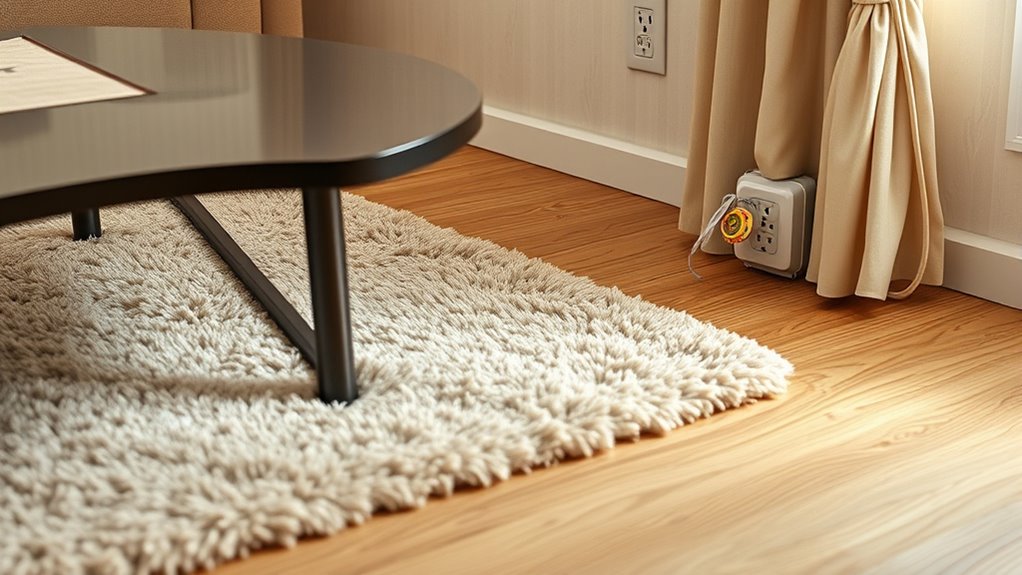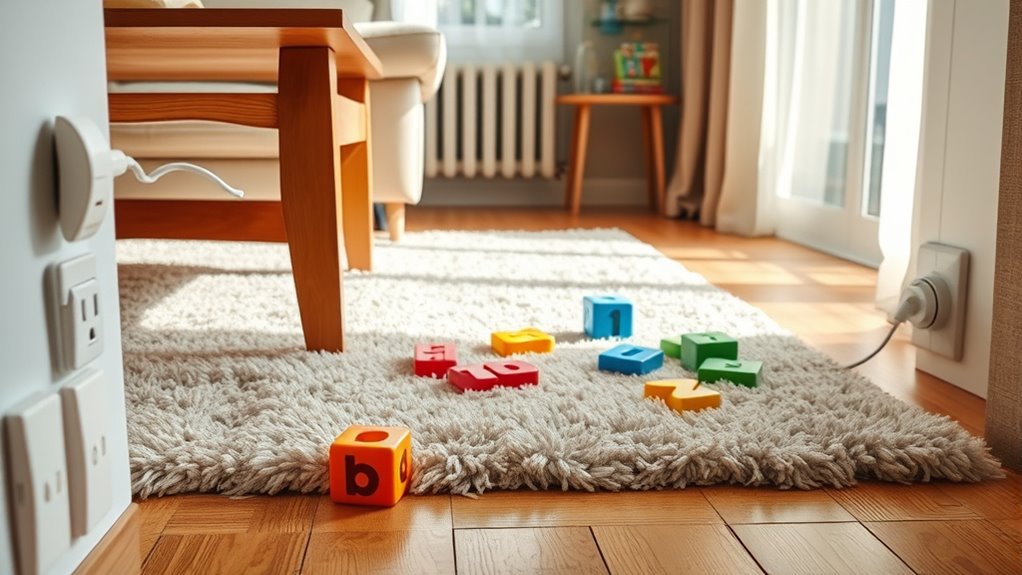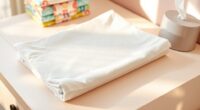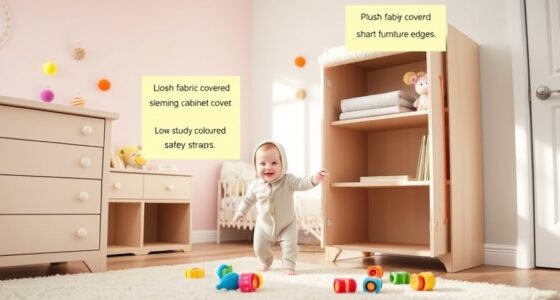Many common household items can hide dangers you might overlook, like unsecured furniture, accessible electrical outlets, or sharp edges on furniture. Curious little ones will find ways to explore, risking injuries or shocks. You should check for loose cords, stabilize furniture, and cover outlets to prevent accidents. Softening sharp corners and securing heavy items are also essential. Stay alert to these hidden risks—if you keep discovering more, you’ll better protect your child from unseen hazards.
Key Takeaways
- Regularly inspect electrical outlets and install safety covers or plates to prevent children from inserting objects or fingers.
- Secure heavy furniture and TVs to walls with appropriate brackets to prevent tipping hazards.
- Check for loose cords, sharp edges, or unsecured items that children could reach or pull over.
- Pad sharp furniture edges and keep small, choking, or strangulation hazards out of children’s reach.
- Continuously evaluate your home environment for hidden dangers, especially as children grow and explore.

Bringing a baby home is exciting, but it also means you need to create a safe environment to prevent accidents. One of the most common hazards new parents overlook is the risk posed by electrical outlets. Outlets are often at your child’s eye level or easily accessible, making them prime targets for curious little hands. To keep your baby safe, consider installing outlet covers or safety plugs that block access without disrupting the look of your home. If you’re willing to take it a step further, outlet safety plates can provide extra protection by covering entire outlets and preventing even the most determined infants from poking fingers or objects inside. Remember, never underestimate your child’s ability to find a way into trouble—what seems harmless now can become dangerous quickly.
In addition to electrical hazards, furniture tips are essential for babyproofing. Your furniture can unintentionally become a hazard if it’s unstable or easy to tip over. Start by anchoring heavy furniture, such as dressers, bookshelves, and TVs, to the wall. Use brackets or straps designed specifically for this purpose, and check that the anchors are secure. Even smaller pieces like chairs or side tables should be stable and placed away from windows or areas where your baby might pull or climb. Avoid placing furniture with sharp edges in areas where your child spends a lot of time; instead, add corner protectors or padding to soften potential impacts. Keep in mind that as your baby grows and begins to explore, they’ll often pull themselves up and hold onto furniture, so it’s essential to ensure everything is firmly anchored and safe.
While it’s tempting to think that the most obvious dangers are enough, many hazards hide in plain sight. Regularly inspect your home for loose cords, sharp edges, or unsecured furniture that could pose a risk. Keep electrical cords out of reach, and use cord shorteners or covers to prevent choking or strangulation hazards. When it comes to furniture tips, always remember that what’s secure today might become loose over time, so periodic checks are necessary. Creating a safe environment isn’t just about removing obvious dangers; it’s about anticipating your baby’s curiosity and making adjustments accordingly. Incorporating awareness of sleep deprivation and its effects can help parents stay alert and responsive to potential hazards. By paying attention to electrical outlets and properly securing furniture, you’ll considerably reduce the chances of accidents and help your little one explore safely.
Frequently Asked Questions
How Often Should I Reassess My Home for New Hazards?
You should do regular home safety checks and set a hazard reassessment schedule to keep your home safe for your little one. Every few months, review areas like cabinets, electrical outlets, and furniture for new hazards. As your child grows and explores, reevaluate more often—at least quarterly—to catch potential dangers early. Staying proactive ensures you maintain a safe environment and address hazards before they become a risk.
Are There Specific Babyproofing Products Recommended for Each Room?
Think of each room as a new chapter in your babyproofing story. You’ll want specific babyproofing gadgets like outlet covers in the living room, safety lock types on cabinets in the kitchen, and corner protectors in the playroom. For bedrooms, consider door knob covers and bed rails. Tailoring safety lock types and gadgets to each space guarantees your little one’s adventures stay safe and secure, room by room.
How Can I Prevent My Baby From Accessing Sharp Edges?
To prevent your baby from accessing sharp edges, you should install corner cushions and edge protectors on furniture and sharp corners. These products act as a soft barrier, absorbing impact and reducing injury risk. Make sure to secure any furniture that could tip over and keep small objects out of reach. Regularly check that the protectors stay in place and replace them if they become worn or loose.
What Are Common Household Plants That Are Toxic to Babies?
Imagine your curious baby grabbing a leaf from a seemingly harmless houseplant. Many don’t realize that popular pet-safe plants like pothos can still be toxic houseplants for babies. These plants, while safe for pets, can cause poisoning if ingested by infants. Always check your houseplants for toxicity and choose baby-safe, non-toxic options to keep your little one safe. Stay vigilant and opt for pet-safe plants to prevent accidental poisoning.
How Do I Childproof Electrical Outlets Effectively?
To guarantee outlet safety, you should use childproofing tips like installing outlet covers or safety plugs. These prevent your baby from inserting objects into electrical outlets. Always supervise your little one around outlets and keep furniture away from them to reduce temptation. Regularly check that covers are secure and in good condition. Childproofing tips like these help create a safer environment and give you peace of mind as your baby explores their surroundings.
Conclusion
Now that you’re aware of these hidden dangers, you can take proactive steps to create a safer home for your little one. Babyproofing is an ongoing process—think of it as putting out fires before they start. Stay vigilant and regularly check for new hazards, because a safe environment isn’t something you can set and forget. With your dedication, you’ll keep your child safe and sound, proving that prevention is truly better than cure.









